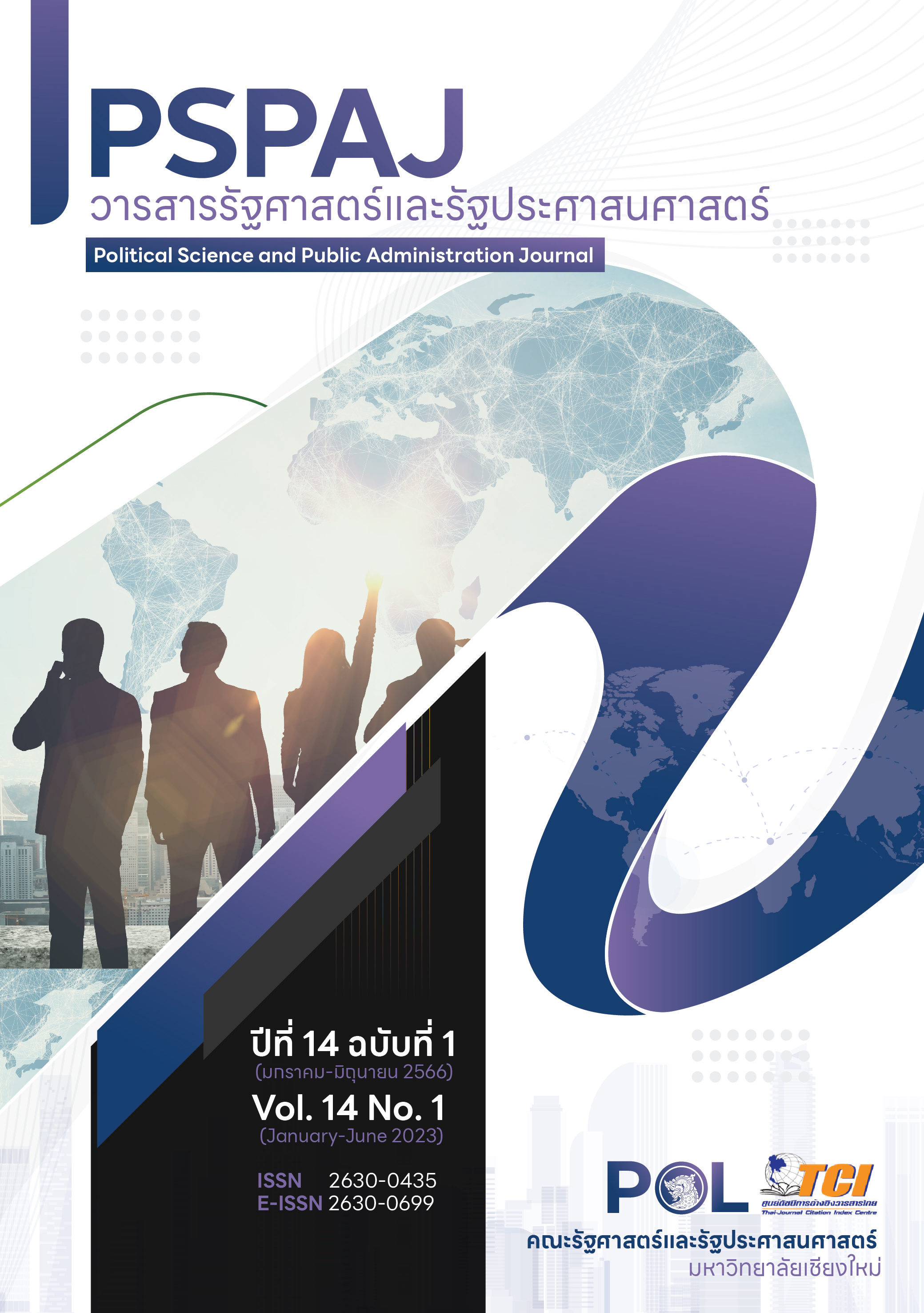Guidelines for Driving the Thailand’s Music Industries in Music Exports
Main Article Content
Abstract
This research aimed to 1) study the role of the government as a driving force of the global exportation of the music industries of South Korea, Japan, and Thailand from 2014 to 2021, 2) study the problems of the driving force of the exportation of the music industry of Thailand from the past until the present, and 3) propose methods to adapt patterns and procedures from Japan and South Korea to Thailand’s music industry exportation. 1) South Korea and Japan’s governments, together with their public sectors, were a major part driving the global exportation of their respective music industries. The governments from the two mentioned countries were determined in supporting the processes including production, advertisement, and marketing. The Thai government, in practice, did not have concrete patterns and procedures. However, strategies to support the film and media industries were established during Phase 3 (2017-2021). 2) The problems of the driving force of Thailand’s global exportation of the music industry were caused by the government, the private sectors, and the public sectors. These include over-controlling bureaucratic systems, a lack of opportunities for music industry experts to develop necessary skills and knowledge, and the production of works that lack Thai identity. 3) Creativity should be stressed as the main quality of Thai music industry individuals to produce unique work by adapting, not imitating, others to create Soft power via the Thai music industry. In addition, the determined cooperation between the government and public sectors can drive the Thai music industry towards success.
Article Details

This work is licensed under a Creative Commons Attribution-NonCommercial-NoDerivatives 4.0 International License.
- เนื้อหาและข้อมูลที่ลงตีพิมพ์ในวารสารรัฐศาสตร์และรัฐประศาสนศาสตร์ถือเป็นข้อคิดเห็นและความรับผิดชอบของผู้เขียนบทความโดยตรง ซึ่งกองบรรณาธิการวารสารรัฐศาสตร์และรัฐประศาสนศาสตร์ ไม่จำเป็นต้องเห็นด้วย หรือร่วมรับผิดชอบใดๆ
- บทความและข้อมูล ที่ได้รับการตีพิมพ์ในวารสารรัฐศาสตร์และรัฐประศาสนศาสตร์ ถือเป็นลิขสิทธิ์ของวารสาร หากบุคคลหรือหน่วยงานใดต้องการนำข้อมูลไปใช้ประโยชน์ในทางวิชาการ ขอให้อ้างอิงแหล่งที่มาด้วย
References
a day BULLETIN. (2563). Dessin the world กับไอเดียสร้างรายได้ที่กำลังเกิดขึ้นในวงการดนตรีญี่ปุ่น. สืบค้นเมื่อ 14 มิถุนายน 2565, จาก https://adaybulletin.com/life-lesson-dessin-the-world-mmusic-label/49050
กรมส่งเสริมอุตสาหกรรม. (2562). อุตสาหกรรมสาร. สืบค้นเมื่อ 14 มิถุนายน 2565, จาก http://ejournal.dip.go.th
กระทรวงวัฒนธรรม. (2559). ยุทธศาสตร์การส่งเสริมอุตสาหกรรมภาพยนตร์และวีดิทัศน์ ระยะที่ 3. กรุงเทพฯ: กระทรวงวัฒนธรรม.
กิตติ ประเสริฐสุข. (2562). Soft Power ของเกาหลีใต้: จุดแข็งและข้อจำกัด. International Journal of East Asia Studies, 22(1), 122-139.
จิรัชญา วรรณโสภาม. (2561). อิทธิพลกระแสเกาหลี (Korean Wave) ต่อการท่องเที่ยวประเทศเกาหลีใต้ของชาวรัสเซีย. กรุงเทพฯ: โครงการรัสเซียศึกษา คณะศิลปศาสตร์ มหาวิทยาลัยธรรมศาสตร์.
ฉัตรชัย งามเลิศ. (2560). ปัจจัยสำคัญต่อการจัดทำรายงานการจัดอันดับเพลงยอดนิยมประจำประเทศไทย (วิทยานิพนธ์ศิลปศาสตรมหาบัณฑิต), สถาบันบัณฑิตพัฒนบริหารศาสตร์.
ชนัญญา กมลยะบุตร. (2556). นโยบายธนูดอกที่สามของนายกอาเบะสู่การฟื้นฟูเศรษฐกิจญี่ปุ่น. สืบค้นเมื่อ 14 มิถุนายน 2565, จาก http://fic.nfi.or.th/japan-desk/upload/file/pdf
ฐณยศ โล่ห์พัฒนานนท์, วรลักษณ์ กล้าสุคนธ์, และศักดิ์สิทธิ์ ทวีกุล. (2562). ความสอดคล้องของโครงสร้างอุตสาหกรรมการผลิตภาพยนตร์ไไทยกับยุทธศาสตร์การส่งเสริมภาพยนตร์และวีดิทัศน์ระยะที่ 3. วารสารนิเทศน์ศาสตร์ธุรกิจบัณฑิต, 13(1), 43-79.
ณทิตา ทรัพย์สินวิวัฒน์. (2560). อุตสาหกรรมเพลงไทยในยุคประเทศไทย 4.0. วารสารวิชาการนวัตกรรมสื่อสารสังคม, 5(1), 157-167.
ดำรงค์ ฐานดี. (2557). จากอนุรักษ์นิยมแบบดั้งเดิมมาเป็นอนุรักษ์นิยมแบบปัก กึนเฮ:กรณีศึกษาประเทศเกาหลีใต้. กรุงเทพฯ: ศูนย์เกาหลีศึกษา มหาวิทยาลัยรามคำแหง.
นันทิพา บุษปวรรธนะ, และนาวิน วงศ์สมบูรณ์. (2563). ความสำเร็จในการเผยแพร่กระแสวัฒนธรรมเกาหลี (Korean Wave): บทบาทของรัฐบาลและอุตสาหกรรมสื่อบันเทิง. วารสารราชภัฏสุราษฎร์ธานี, 7(2), 1-25.
สำนักเลขาธิการนายกรัฐมนตรี. (2565). วัฒนธรรมท่องเที่ยว. สืบค้นเมื่อ 16 มิถุนายน 2565, จาก https://www.thaigov.go.th/news/contents/details/48772
สำนักงานส่งเสริมเศรษฐกิจสร้างสรรค์. (2563). อุตสาหกรรมดนตรีในประเทศไทย. CEA Outlook จับกระแสอนาคต เศรษฐกิจโลก, 4(1), 33.
สำนักงานส่งเสริมเศรษฐกิจสร้างสรรค์. (ม.ป.ป.). อุตสาหกรรมงานฝีมือและหัตถกรรมภายใต้นโยบาย Cool Japan. สืบค้นเมื่อ 26 มิถุนายน 2564, จาก https://www.cea.or.th/th/single-research/cool-japan
สำนักงานส่งเสริมการค้าในประเทศ ณ กรุงโซล. (2561). รายงานตลาดคาแรคเตอร์ในประเทศเกาหลีใต้. กรุงเทพฯ: สำนักงานส่งเสริมการค้าในประเทศ ณ กรุงโซล.
หทัยธาร ฉัตรเลิศมงคล. (2564). สำรวจก้าวต่อไปของ T-Pop และอุตสาหกรรมเพลงไทยสู่เวทีสากลผ่านคนคุณภาพจากวงการเพลง. สืบค้นเมื่อ 16 มิถุนายน 2565, จาก https://thestandard.co/t-pop-and-thai-music-industry-to-international-stage/
อจินไตย เฮงรวมญาติ. (2560). การพัฒนาและส่งเสริมผลิตภัณฑ์วัฒนธรรมไทย (CPOT) โดยใช้รูปแบบจากนโยบาย Cool Japan. กรุงเทพ: สำนักงาน ก.พ.ร.
Cool Japan Fund Inc. (2021). What is Cool Japan Fund. Retrieved June 24, 2021, from https://www.cj-fund.co.jp/en/about/cjfund.html
Cudahy, H. (2007). The Music Industry Business Model. Retrieved October 10. Retrieved June 24, 2021, from https://www.slideshare.net/gangofour/the-music-industry-business-model
IFPI. (2019). IFPI Global Music Report 2019. London: IFPI.
Monty, A. (2010). Micro: Global Music Made in J-pop?. Inter-Asia Cultural Studies, 11(1), 123-128.
Oh, I., & Lee, H. (2014). K-pop in Korea: How the Pop Music Industry Is Changing a Post-Developmental Society. Cross-Currents: East Asian History and Culture Review, 3(1), 72-93.
Passman, D. S. (2011). All You Need to Know About the Music. London: Penguin Books.
Pastukhov, D. (2019). The Mechanics of Recording Industry: A Brief History & Its Functions. Retrieved June 14, 2021, from https://soundcharts.com/blog/mechanics-of-the-recording-industry#the-structure-of-the-recording-industry.
The Government of the Republic of Korea. (2017). Five-years Plan of Moon Jae-In Administration. Chang Wa De: Korean.
UNESCO. (2015). The Globalization of Cultural Trade: A Shift In Consumption. Retrieved June 20, 2020, from https://en.unesco.org/creativity/files/globalisation-cultural-trade-shift-consumption


